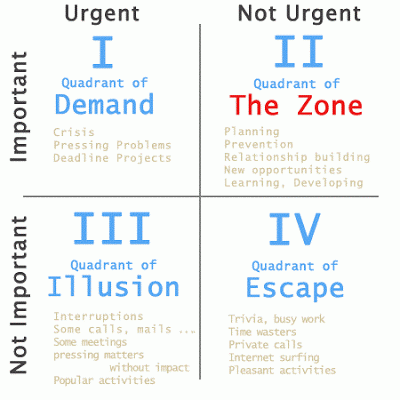‘My advice is to never do tomorrow what you can do today. Procrastination is the thief of time.’—Charles Dickens
The problem with procrastination is that it is just too easy to do. If there is still one week until the essay is due, surely there is time to watch a few more episodes of your favourite TV programme? After decades of studying and working as an editor, I am all too familiar with procrastination strategies and the process of internal bargaining. Depending on the dullness or complexity of the task, sometimes even mopping the floor or tackling the ironing basket is a preferable option. On the surface, the solution is time management. This is certainly a valuable skill, particularly with ongoing and lengthy tasks such as theses and research projects.
Time Management and the 7 Habits of Highly Effective People
Stephen Covey’s 7 Habits of Highly Effective People has a matrix that prioritises tasks according to urgency and importance. For chronic procrastinators keen to change, this matrix could be extremely helpful. Reformed procrastinators can visualise how much time they have to begin a task before stress and deadline pressures set in.

Just Do It
There are several types of procrastinators; no single solution will suit every person. During my tertiary years, I was a motivation procrastinator. Essays would sit there, patiently waiting for my motivation levels to miraculously peak. Of course, this rarely happened, and assessment tasks ended up in what Covey would term the ‘urgent and important’ box (the ‘quadrant of demand’ in the above image). Years ago, fitness guru Michelle Bridges described motivation as a ‘bad boyfriend’; it is never there when you need it. Bridges says to ‘just do it’. It is a simple philosophy but, for me, it is very powerful.
Eat a Frog
The ‘eat a frog’ analogy (attributed to Mark Twain and Brian Tracy) is also terrific for motivation procrastinators. Twain apparently said ‘Eat a live frog first thing in the morning and nothing worse will happen to you for the rest of the day’. In time management terms, the frog is the unpleasant task. If you eat your frog in the morning, the rest of the day is free from pressure and guilt. Perhaps your frog is a few hours of research. Maybe it is data collection or collation.
Tell-tale Signs
Thankfully, a career filled with deadlines has mostly curbed my procrastinating habits. As an editor, I can now identify the hallmarks of procrastination in essays and theses. Documents begin with energy, accuracy and vibrancy. The middle of the document is usually where mistakes start creeping in. Citations often become inconsistent and lacking in detail. By the end of the document, there is a sense that the writer simply wants the task done.
Procrastination and You
Some people work quite well under pressure, and deadlines are the best motivators for these types of procrastinators. For others, there is a very real possibility that the last-minute rush that follows procrastination may negatively affect performance. This is one of the greatest drawbacks of procrastination. Dickens identified procrastination as a ‘thief of time’. Potentially, it is also a thief of success.
So, keep off Facebook and Twitter. Create your own time management matrix. Or eat a frog. Just do it. The future you will thank you.

